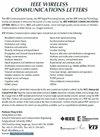全息MIMO信道估计的张量分层稀疏恢复
IF 5.5
3区 计算机科学
Q1 COMPUTER SCIENCE, INFORMATION SYSTEMS
引用次数: 0
摘要
全息MIMO (HMIMO)已经成为下一代无线网络的一项有前途的技术,利用密集的大规模天线阵列以前所未有的空间分辨率捕获电磁传播。在HMIMO系统中,实现准确的信道估计对于确保可靠的无线通信至关重要。然而,现有的基于三维von Mises-Fisher (vMF)分布的估计方法和传统的稀疏恢复技术忽略了散点聚类分布固有的层次稀疏性。为了解决这一问题,提出了一种新的HMIMO信道估计方法,该方法可以在波数域揭示HMIMO信道的高维张量分层稀疏结构,其中非零支撑在信道张量的规则列或行中表现出来。利用这种特殊的结构,提出了一种张量分层正交匹配追踪(THOMP),实现了准确的支持重建,从而获得了良好的信道估计性能。此外,构造了一个张量层次先验信息(THPI),使得具有先验信息的THOMP (THOMP- p)在THPI不能准确指示HMIMO信道整体支持的反直觉场景下可靠高效。仿真结果验证了我们提出的THOMP-P的优越性能,特别是在低信噪比的情况下,通过选择更精确的非零支持。本文章由计算机程序翻译,如有差异,请以英文原文为准。
Tensor Hierarchical Sparse Recovery for Holographic MIMO Channel Estimation
Holographic MIMO (HMIMO) has emerged as a promising technology for next-generation wireless networks, leveraging densely packed large-scale antenna arrays to capture electromagnetic propagation with unprecedented spatial resolution. In HMIMO systems, achieving accurate channel estimation is crucial to ensuring reliable wireless communications. However, existing estimation methods coming from the 3D von Mises-Fisher (vMF) distribution and the conventional sparse recovery techniques neglect the hierarchical sparsity inherent in the clustered distribution of scatterers. To address this issue, a novel HMIMO channel estimation methodology is proposed, which could reveal a high-dimensional tensor hierarchical sparsity structure of HMIMO channel in the wavenumber domain, where the nonzero supports exhibit in regular columns or rows of the channel tensor. By leveraging this specific structure, a tensor hierarchical orthogonal matching pursuit (THOMP) is proposed, which enables accurate support reconstruction, thereby yielding favorable channel estimation performance. Furthermore, a tensor hierarchical prior information (THPI) is constituted, facilitating a THOMP with prior information (THOMP-P), which is reliable and efficient in counterintuitive scenarios where the THPI fails to accurately indicate the whole supports of the HMIMO channel. Simulation results validate the superior performance of our proposed THOMP-P, particularly in low signal-to-noise ratio scenarios by way of selecting more accurate nonzero supports.
求助全文
通过发布文献求助,成功后即可免费获取论文全文。
去求助
来源期刊

IEEE Wireless Communications Letters
Engineering-Electrical and Electronic Engineering
CiteScore
12.30
自引率
6.30%
发文量
481
期刊介绍:
IEEE Wireless Communications Letters publishes short papers in a rapid publication cycle on advances in the state-of-the-art of wireless communications. Both theoretical contributions (including new techniques, concepts, and analyses) and practical contributions (including system experiments and prototypes, and new applications) are encouraged. This journal focuses on the physical layer and the link layer of wireless communication systems.
 求助内容:
求助内容: 应助结果提醒方式:
应助结果提醒方式:


